Cluster flies are large black coloured flies with the scientific name ‘ Pollenia rudis’, they show up in homes from late fall through early spring.
A Cluster fly is very much similar to a house fly.
Cluster flies come from the ‘Calliphoridae’ family. This is the same family to which bottle or blow flies belong.
Cluster flies are also known as attic flies. This name describes its characteristics very well i.e. the tendency of clustering in large numbers inside attics.
Unlike blow flies, cluster flies do not reproduce indoors and so home owners do not have to worry about the flies originating from a dead animal carcass or any other unpleasant material within the attic or walls.
Cluster flies emerge in the summer or autumn. Often in large numbers, they enter houses in order to find some warm places where they can hibernate. These flies do not bite humans and are strictly parasitic on earth worms.
Cluster Flies Fact Sheet:
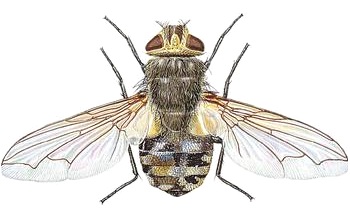
Now let’s see some important facts about cluster flies:
Physical Appearance:
The physical appearance of a cluster fly resembles very much to house or a bottle fly. Adult cluster flies are dark gray in color and about 8 – 10 mm long. They have yellowish golden hairs on their thorax. The abdomen of a cluster fly has a prominent dark and light coloured chequered pattern.
Unlike house flies they do not have dark stripes on their thorax and also they don’t have bluish or greenish metallic coloured bodies like the ones that bottle flies have. At rest, both the wings of a cluster fly overlap across the abdomen.
They may give off a sickly, sweetish odour like buckwheat honey if disturbed. Another important feature of cluster flies is that they are slow and sluggish.
Habitat and Behaviour:
As soon as the fall approaches, the cluster flies begin to enter homes and buildings in large numbers. At this time of the year, the days become shorter and temperature begins to fall, hence they enter human houses in search for overwintering sites.
And as during this time the west and south facing buildings are exposed to more sunlight, so the cluster flies are attracted more to such buildings due to the warmth they can get there. They enter these buildings through small openings or cracks and crevices near window or door frames, open or unscreened windows/vents.
Once inside they gather together in an isolated, safe place such as attics or false ceilings and begin to hibernate. Generally these sites are the upper south or west sides of the buildings. Once the temperature again crosses 12 degree Celsius they become active.
If the temperature inside the building is manually controlled above 12 degree Celsius, the cluster flies may come out thinking it is spring. Cluster flies are strongly attracted to light, so you can also find them near windows and near lamps at night.
Check out this article: What Attracts Flies Into Your Home Or Surroundings?
Feeding Habits:
Cluster flies are not harmful to property, they enter buildings in the autumn simply to hibernate and nothing else. They do not have biting mount parts like horse flies or gnats. Unlike blow flies cluster flies are not associated with animal carcass, faeces, or woollens.
Cluster flies are strictly parasitic on earthworms. After hatching from eggs the cluster fly larvae find and burrow into the body of an earthworm to feed. The poor worm does not usually survive the experience.
Life Cycle:
In general, per season there are at least 3 to 4 generations of cluster flies. The beginning of a typical cluster fly lifecycle begins after the adults leave their over-wintering sites in the spring and lay eggs on the soil that contains earthworms. The eggs are mostly laid in the soil cracks.
After 3 – 4 days these eggs hatch and the maggots (larvae) enter the body cavities of earthworms. These larvae then feed on the host earthworms for few days. The maggot stage in cluster flies lasts in about 13 to 22 days.
After this they molt and pupate in the soil. Pupal stage lasts 11 – 14 days after which adult flies come out and are ready to start the cycle again. The total lifecycle of a cluster fly is of 30 – 50 days.
Damages:
- They are predominantly considered as a nuisance because of their habit of hibernating inside human houses. But they do not cause any damage the homes.
- These flies sometimes leave tiny dark-coloured spots of excrement on walls or windows, but these spots are not known to carry any human disease causing organisms.
- Cluster flies may give out a strange odour when disturbed.
- Also, if flies die in wall voids, they may attract larder beetles.
Difference between a House Fly, Bottle Fly and a Cluster Fly:
Cluster fly is very different from a house or a bottle/blow fly. Below features can help you to distinguish between a house or bottle fly from a cluster fly: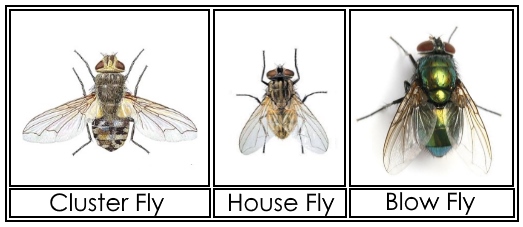
Cluster flies (8 – 10 mm) are larger in size than a house fly (6 – 7 mm) but smaller than a bottle fly (10 – 14 mm). Cluster flies are a bit darker and have dark and light chequered pattern on their abdomen which house flies or bottle flies do not have. Cluster flies have short yellow or golden coloured hairs on their thorax.
In appearance, bottle flies can be easily distinguished from the other two types of flies, as they have a greenish or a bluish metallic coloured body. Another important aspect that can differentiate between a cluster fly and a house fly is the speed of movement. House and bottle flies are lightening quick whereas cluster flies are slow and sluggish.
If you notice carefully a cluster fly at rest, you will see its wings overlap, whereas housefly’s wings remain separate during rest. Cluster flies enter homes in order to search for a warmer place to hibernate whereas houseflies enter human houses in search of food and water.
How to Prevent Cluster Flies:
The best way to avoid Cluster flies is by mechanical exclusion. Cluster flies can enter your homes through the smallest cracks around door and window frames or through any other tiny unsealed opening.
To prevent cluster fly infestation you could use following tips:
- Fill all the cracks or crevices, in walls, window or door frames with caulking. Make sure to seal every possible hole or crack like (around – windows, doors, siding, behind chimneys, utility pipes, underneath the fascia etc) in the building.
- If there are any damaged screens on doors or windows they should be repaired or replaced.
- Try to install insect screening or mosquito nets over air vents in soffits.
- In addition to the above tips you could also use synthetic pyrethroid or neonicotinoids insecticides like (bifentrin, cyfluthrin, lambda-cyhalothrin, cypermethrin, deltamethrin, sumithrin, tralomethrin, dinotefuran etc) on the south and west side walls of your homes to deter cluster flies. But make sure to repeat the application after every 2 – 3 days.
Recommended Reading: How to get rid of house flies outside
How to Get Rid Of Cluster Flies:
In this section, we will see how you can get rid of cluster flies after they have gained access to the interiors of your home. In such situations you could use the following methods:
Use of Insecticidal Aerosol Sprays:
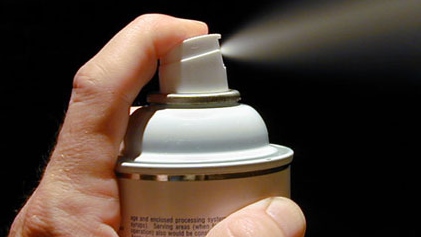
Once the cluster flies have entered your home and you have identified the infested site, then this is the best method you can use to kill them.
Scientific studies have indicated that indoor aerosol pyrethrin based insecticides are quite effective in killing exposed flies during the winter and spring months. These pyrethrin based insecticides are prepared from natural plant extracts and hence are safe to be used indoors.
Such pyrethrin based insecticides are also safe for pets and are effective against a vast majority of flies and pests. But please make sure to clean the dead insects because there is a possibility that these dead flies may attract carpet beetles that will first feed on the dead insects and later attack woollens.
You can check out this pyrethrin based insecticide at Amazon.
Use of Mini Vacuums (My favourite Method):
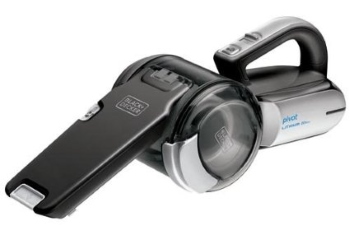
As we know that, cluster flies enter our houses in order to find some places where they can hibernate and hence during this period they are slow and sluggish. And because they are sluggish you could easily use a mini vacuum to catch them.
This is my favourite method as it is simple and doesn’t force you to deal with chemicals or mess. For this task, I have Black Decker BDH2000PL which is lightweight, portable and gives the adequate suction power.
You can check out Black Decker BDH2000PL here on Amazon.
Note: Please make sure to clean your vacuum after use, otherwise cluster flies can release an unpleasant odour inside the vacuum dirt bag.
Use of UV Light Traps:
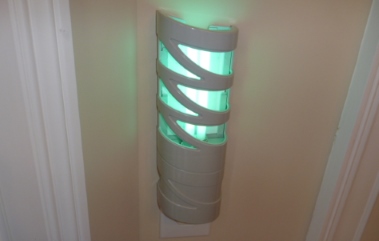
Another way to get rid of cluster flies is to use the UV light traps. These bright light traps consist of a small but high intensity UV lamp and adhesive glue boards. Cluster flies are attracted to the UV Light and as soon as they land on the lamp they get stuck on the glue boards.
The glue boards are replaceable and can be replaced after few days or months. Such fly traps consume 9-12 watts of energy and are effective in 600-800 square feet.
Check out this one on Amazon, it has lots of positive reviews.
Use of Cluster Buster:
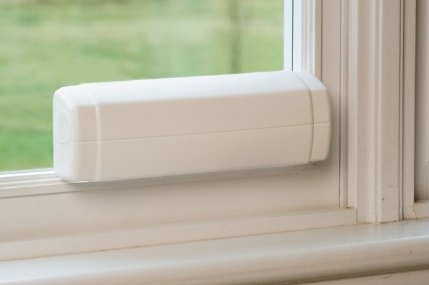
Cluster Buster is a revolutionary product to get rid of cluster flies. Most people say it works like a charm against the cluster flies. You just have to fasten the trap inside the glass of any window near the infested area. The traps are filled with super finely ground (powdered) egg shell.
Also there is a cross section at the top of the trap. The light from outside when enters the trap, then the translucent walls of the trap emit a light that attracts the cluster flies. Once the flies enter the trap and land on the powdered egg shell, they actually sink into the powder as it is very light and fluffy and hence a ‘quicksand effect’ is produced.
The powdered egg shell clogs the openings in the cluster flies respiratory system and hence kills it instantly. These traps are non toxic and a single trap can be used for 2 – 4 years and can kill up to 1000 flies.
Check out Cluster Buster on Amazon.
So, this was all about cluster flies and the methods that can be used to get rid of them. Do let us know your stories or any other methods that you find useful against cluster flies.
Cheers 🙂










For the last two days we have been overrun by cluster flies and didn’t know how to deal with it. After reading all the information you have I am not so worried, I thought they must be coming from a dead animal but now I understand how it all works. Thanks for all the information.